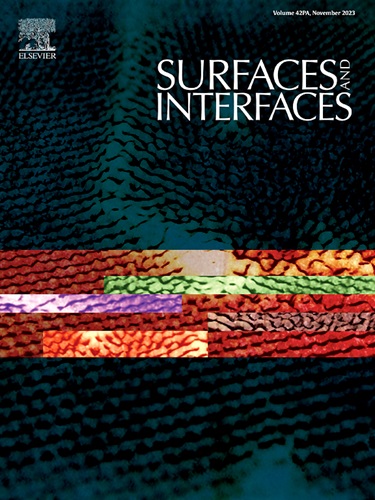温度和反应时间对BaTiO3纳米颗粒光催化降解水中有机污染物性能的影响
IF 5.7
2区 材料科学
Q2 CHEMISTRY, PHYSICAL
引用次数: 0
摘要
开发低成本、高性能的光催化剂是推进光催化技术在有机废水处理中的应用的关键。在本研究中,通过水热法合成钛酸钡(BaTiO3)纳米颗粒,然后在600°C下煅烧,并评估其光催化降解阳离子和阴离子染料(如亚甲基蓝(MB)和甲基橙(MO))的活性。系统地研究了水热温度和反应时间对相组成、结晶度、形貌和光学性质的影响。所有合成的样品都呈现出立方的BaTiO3相,含有不同水平的BaCO3杂质。元素分析显示在135°C和150°C时Ba:Ti比接近化学计量,而在175°C时观察到Ba富集。最佳样品在150°C下合成48 h,具有纳米颗粒和纳米棒的混合形态,带隙3.02 eV,结晶度高,降解效率为93% (MB)和43% (MO),速率常数分别为0.214和0.023 min-1 g-1。清道夫实验发现光生空穴(h +)是主要的活性物质,超氧自由基(•O2 -)起次要作用。催化剂表面与阳离子染料之间良好的静电相互作用使其对甲基溴的选择性优于钼。对照实验证实了降解过程的光催化性质。这项工作强调了控制合成参数和相纯度对提高BaTiO3光催化性能的重要性,并为设计高效的环境修复材料提供了见解。本文章由计算机程序翻译,如有差异,请以英文原文为准。
Influence of temperature and reaction time on photocatalytic performance of BaTiO3 nanoparticles for organic pollutant degradation in aqueous environment
Developing low-cost, high-performance photocatalysts is crucial for advancing photocatalytic technologies in organic wastewater treatment. In this study, barium titanate (BaTiO3) nanoparticles were synthesized via a hydrothermal method followed by calcination at 600 °C and evaluated for their photocatalytic activity toward the degradation of cationic and anionic dyes such as methylene blue (MB) and methyl orange (MO). The effects of hydrothermal temperature and reaction time on phase composition, crystallinity, morphology, and optical properties were systematically investigated. All synthesized samples exhibited a cubic BaTiO3 phase, with varying levels of BaCO3 impurities. Elemental analysis revealed near-stoichiometric Ba:Ti ratios at 135 °C and 150 °C, while Ba enrichment was observed at 175 °C. The optimal sample, synthesized at 150 °C for 48 h, featured a mixed morphology of nanoparticles and nanorods, a band gap of 3.02 eV, and high crystallinity, achieving degradation efficiencies of 93 % (MB) and 43 % (MO) with rate constants of 0.214 and 0.023 min–1 g–1, respectively. Scavenger experiments identified photogenerated holes (h⁺) as the dominant reactive species, with superoxide radicals (•O2–) playing a secondary role. The selectivity toward MB over MO was attributed to favorable electrostatic interactions between the catalyst surface and the cationic dye. Control experiments confirmed the photocatalytic nature of the degradation process. This work highlights the importance of controlling synthesis parameters and phase purity to enhance BaTiO3 photocatalytic performance and provides insight for designing efficient materials for environmental remediation.
求助全文
通过发布文献求助,成功后即可免费获取论文全文。
去求助
来源期刊

Surfaces and Interfaces
Chemistry-General Chemistry
CiteScore
8.50
自引率
6.50%
发文量
753
审稿时长
35 days
期刊介绍:
The aim of the journal is to provide a respectful outlet for ''sound science'' papers in all research areas on surfaces and interfaces. We define sound science papers as papers that describe new and well-executed research, but that do not necessarily provide brand new insights or are merely a description of research results.
Surfaces and Interfaces publishes research papers in all fields of surface science which may not always find the right home on first submission to our Elsevier sister journals (Applied Surface, Surface and Coatings Technology, Thin Solid Films)
 求助内容:
求助内容: 应助结果提醒方式:
应助结果提醒方式:


